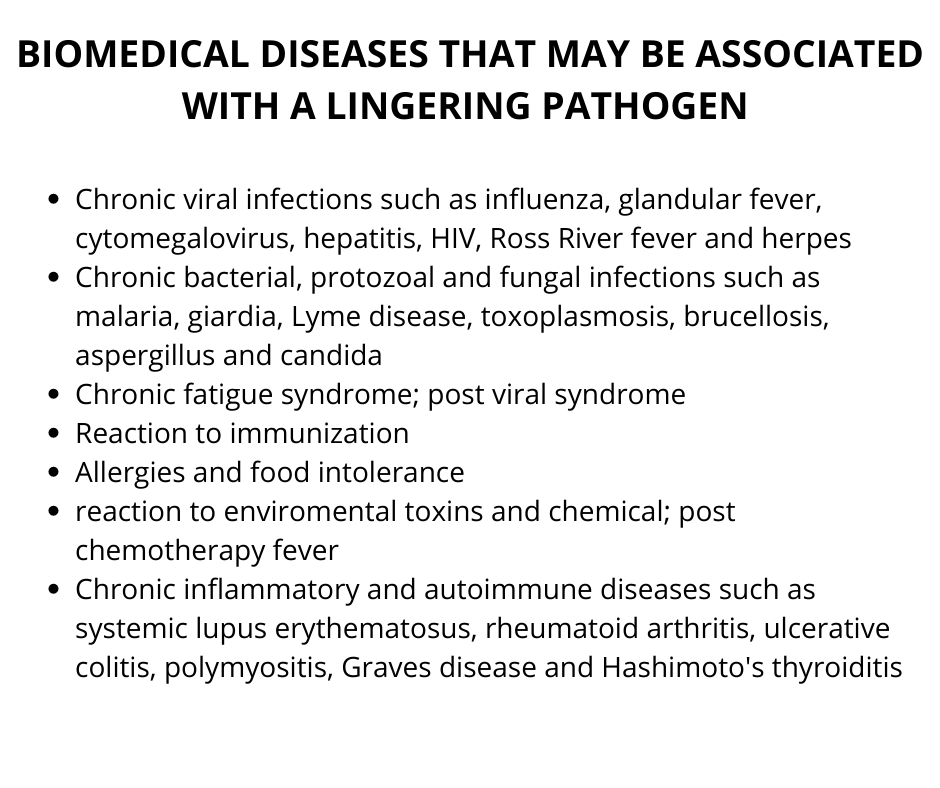
Lingering pathogens are pathogenic influences that remain in the body and provoke a persistent immune response that produces characteristic signs and symptoms. Pathogenic influences in this context including living organisms (viruses, bacteria, fungi and parasites) as well as allergens, chemicals, drugs and environmental toxins.
Lingering pathogens manifest in a number of ways. An infection from the the past may still be making its presence felt with recurrent symptoms (often arising when the patient is stressed or run down), or is perhaps detectable as persistent antibodies or other markers, in blood tests.
In clinic we often suspect a lingering pathogen when the patient presents with a history that begins ‘I have never been well since…’. They are usually referring to an acute infection they suffered some time ago, and occasionally an immunisation. Alternatively, the initial insult which has left the patient with chronic or recurrent symptoms may have been exposed to environmental toxins such as volatile gases, fumes, heavy metals, or in some cases drugs or substances causing an allergic reaction.
In some cases, the initial infection or injury is not recalled or apparent, however the pattern of recurrent symptoms fits the picture of a lingering pathogen and will be treated as such.

How to Identify a Lingering Pathogen
There are a number of signs and symptoms that point to the presence of a lingering pathogen. Not all will be present in any particular individual, and their appearance can vary depending on any complicating condition, the age of the patient and any medications the patient may be taking.
A thorough physical examination is essential in the discovery of lingering pathogens, as signs like abnormal heat distribution or isolated sweating may be quite subtle and not obvious to the patient.
A physical examination, in the context of lingering pathogens, requires systematic assessment of the neck for lymphadenopathy, observation of the tonsils for swelling, and palpation of the skin of the arms and hands, chest, head and feet for abnormal temperatures sensation and moisture.
Low Grade Fever and Abnormal Heat Sensations
A fever is an abnormal elevation, or the perception of an elevation in body temperature, that may be either systemic or localised. The fever type most typical of a lingering pathogen is a low grade fever, but depending on the duration of the condition, the degree of dampness and any complicating deficiency, the heat sensation can vary considerably. Abnormal heat sensations in the body may also point to the possibility of a lingering pathogen, and these may be subjective or objective. When subjective, the patient feels hot or heat intolerant in one part of the body – the hands and feet, head and chest are common. The heat may be suggested by symptoms such as night sweats, flushing, light or inadequate dressing for the weather, or throwing the bedclothes off the feet at night. When objective, the patient is generally unaware of any heat, and it is detected by the practitioner during the course of the examination.
Swollen Lymph Nodes and Tonsils
Palpable lymph nodes in the neck are common findings, and often the initial clue that points towards a lingering pathogen diagnosis. The nodes have a very specific feel. Lymph nodes suggestive of a lingering pathogen are non tender or slightly tender, well defined, round, soft or slightly rubbery and yielding. They feel like small peas under the skin, and are able to be moved slightly over the subcutaneous tissue. Lymph node swelling can come and go during to course of the prolonged lingering pathogenic illness. The more swollen the glands are, the more tender they can be.
Chronically swollen tonsils are another important indicator, especially in children, and obvious with oral examination. The tonsils are enlarged, but not red or inflamed. There is rarely any pain, but the enlarged tonsils may cause some irritation or difficulty swallowing.
Abnormal Sweating
Abnormal sweating is a common finding in patients with lingering pathogen, and one that is easy to overlook. Troublesome, debilitating or embarrassing sweating will be reported, but patients are often insensible to sweating, or it is considered normal and thus disregarded. Some abnormal sweating includes:
> Night sweats
> Spontaneous sweating
> Sweating on parts of the body (such as on the hands and feet, chest, head and neck, upper abdomen, armpits or genitals)
> Sour, strong or otherwise unusual smelling sweat
Muscle and Joint Aches
The aching is felt deep in the muscles and tends to be diffuse. It can be associated with a distinct feeling of heaviness or weakness, and most commonly affects the large proximal muscles. The thighs and hips, buttocks and waist, and the upper arms are common locations. Soft tissue around joints can be affected as well, so both muscles and joints may ache.
Energy Levels
Persistent fatigue since previous illness, or sudden and otherwise inexplicable drop in energy lasting from a few hours to days or longer, may suggest a lingering pathogen, when accompanied by abnormal heat, sweating or lymph node swelling.
Tongue
Certain features of the tongue, in particular the prominent red protrusions (thorns) that appear anteriorly, around the edges of the tongue and on the root of the tongue, are suggestive of a lingering pathogen. The distribution of the thorns can give clues as to the depth of the pathogen. The other main benefit of the tongue is as a prognostic indicator and a measure of how well a treatment is progressing.
Skin Lesions and Rashes
Skin lesions and rashes characteristic of lingering pathogens include macules, papules and vesicles. Macules and papules often appear together as a maculopapular rash.
> Macules are flat, dull red, brown or purple, contiguous with the skin, and may appear on the trunk and extremities.
> Papules are raised lesions like small pale pimples, appearing mostly on the trunk.
> Vesicles are small fluid filled blisters which can appear anywhere on the body.

Etiology
Weakness of anti-pathogenic qi
Any per-existing constitutional or acquired weakness can predispose patients to a pathogenic invasion, which they cannot repel. Weakness of Lung and Spleen qi can enable a pathogen to penetrate into the qi level. Weakness of the Kidneys can enable deeper penetration in the ying, blood and shaoyin levels.
Overwork
One of the most common contributing factors is failure to rest and look after oneself during and acute illness. Patients who try to ‘sweat it out’ and soldier on, or simply ignore illness and continue to work through it, are especially likely to end up with a lingering pathogen.
Overwork in general, both physical and mental, drains the basic reserves of yuan qi and weakens the Kidneys. This weakness enables a pathogen to easily enter, and once in to linger.
Immunisation
Immunisations may cause a lingering pathogen in some circumstances. Patients who are weak to start with, or who are vaccinated during an acute illness, are especially vulnerable.
Antibiotics during acute viral illness
Antibiotics are bitter and cold, and can weaken Spleen yang qi. They effectively clear out heat, but are unable to completely disperse the pathogen, so a residue, often from damp, is left behind, crating a medium from repeated infection.
Wrong Treatment
Wrong or poorly administered treatment for the type or location of a pathogen can weaken anti-pathogenic qi, trap pathogen or drag it deeper into the body.
Environmental Exposure
Repeated exposure to certain climates, chemicals or toxins can lead to a lingering pathogen pattern. The climatic factors are the most common, with prolonged exposure to hot or humid weather, a damp house or frequent contact with water, especially when tired or vulnerable, enabling dampness and damp heat to seep into the body.
Exposure to farm and industrial chemicals, pesticides, volatile fumes and pollutants can induce a lingering pathogen reaction in some people, especially those already weakened or vulnerable due to constitution, age or pre-existing illness.
Strong Pathogen
A strong or epidemic pathogen can overwhelm even the most robust of defences, deplete qi and damage yin, and become persistent. This is seen in certain new strains of flu and other viral and bacterial illnesses.
Drugs
Some drugs weaken the Spleen and can damage qi, for example, laxatives and antibiotics. Some drugs deplete yin, weaken the Kidneys and open the shaoyin to invasion. These include stimulates such as amphetamines and cocaine, antidepressants, steroids and cytotoxic agents.
Emotional Factors
Any emotional factor that leads to depletion of Spleen, Lung or Kidney qi can enable a pathogen to get past the body’s defences and into the deeper levels where the weak qi is unable to adequately expel it.
Treatment
Acupuncture is the treatment of choice and herbal medicines are recommended to support correcting any systemic imbalances that may be present.
